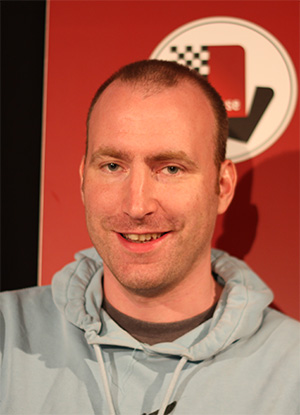Primer torneo temático Fritztrainer
Presentado por GM Daniel King y Arne Kaehler
Lunes, 17.05.2021 a partir de las 19:00 CEST.
El torneo se disputará por sistema de liga a doble vuelta. Cada uno de los participantes puede elegir dos aperturas.
La aperturas serán sorteadas al azar antes de cada ronda.
Control de tiempo: 5 minutos, más 3 segundos de incremento.
The time-limit is 5 minutes + 3 seconds.
¿Quién ganará el torneo?
Fritztrainer-Tournament
GM Daniel King y Arne Kaehler serán los presentadores de esta velada de ajedrez.
 Daniel King en YouTube
Daniel King en YouTube
Daniel King emplea el nuevo sistema de entrenamiento con vídeos interactivos para afinar las habilidades del espectador como atacante y desarrollar su intuición sobre cuándo hay que lanzar un ataque.
Los jugadores
Merijn van Delft
 Merijn van Delft is an International Master from the Netherlands who lived in Hamburg for many years and is currently based in Amsterdam. After scoring a GM norm in 2017 he is eager for more. His ChessBase show on Wednesday evenings has been running for over ten years now.
Merijn van Delft is an International Master from the Netherlands who lived in Hamburg for many years and is currently based in Amsterdam. After scoring a GM norm in 2017 he is eager for more. His ChessBase show on Wednesday evenings has been running for over ten years now.
Merijn's activities as a full-time chess professional include training both top juniors and ambitious amateurs, coaching at tournaments, writing articles and books, doing live commentary, organizing tournaments and other chess events.
The Dutsch IM has only created one Fritztrainer, which is focusing on the bishop. Since he cannot choose his own opening for this event, he is probably considered an underdog in this tournament. Nevertheless, he has certainly acquired an extended opening repertoire with his weekly "Game of the Week" show, and will use his wild card bravely.
Robert Ris
 Robert Ris (born 1988) is an International Master (FIDE 2450+) who mostly spends his time training and coaching talented youngsters. On the PlayChess server The Fast and the Furious is a popular show where he explains sharp opening lines for a wider audience. He is also a well-known ChessBase author who produced numerous DVDs and regularly contributes to ChessBase Magazine as well. Since 2015 he is the organizer of the Dutch Rapid Championships in his home town Amstelveen.
Robert Ris (born 1988) is an International Master (FIDE 2450+) who mostly spends his time training and coaching talented youngsters. On the PlayChess server The Fast and the Furious is a popular show where he explains sharp opening lines for a wider audience. He is also a well-known ChessBase author who produced numerous DVDs and regularly contributes to ChessBase Magazine as well. Since 2015 he is the organizer of the Dutch Rapid Championships in his home town Amstelveen.
The youngest participant in the Fritztrainer tournament, unlike his Dutch colleague Merijn van Delft, has already launched eleven Fritztrainers. Even if the openings are less central in the selection, Robert Ris has analysed and tested several interesting openings through his weekly "Fast and Furious" show. Especially the "sharp" gambits suit the IM particularly well, and he is not afraid to sacrifice a piece or two for a better position.
Mihail Marin
 born in 1965, has several times been Romanian champion and first made the leap over the Elo barrier of 2600 in 2001. Marin possesses a rare gift for a grandmaster - he is able to explain in readily comprehensible terms the ideas behind moves, variations and positions. This ability is there for all to admire in his contributions to ChessBase Magazine. Marin has written some books which have earned the highest of praise, among which are "Secrets of Chess Defence" and "Learn from the legends". Marin lives in Bucharest and is married to Mariya Marin.
born in 1965, has several times been Romanian champion and first made the leap over the Elo barrier of 2600 in 2001. Marin possesses a rare gift for a grandmaster - he is able to explain in readily comprehensible terms the ideas behind moves, variations and positions. This ability is there for all to admire in his contributions to ChessBase Magazine. Marin has written some books which have earned the highest of praise, among which are "Secrets of Chess Defence" and "Learn from the legends". Marin lives in Bucharest and is married to Mariya Marin.
With already 14 Fritztrainers, and many reviews of the Masterclass episodes, the GM from Romania certainly has the most experience of our four candidates. His complete repertoire with 1.c4 is in the foreground, and one can look forward to many tactical tricks from Marin.
Rustam Kasimdzhanov
 born in 1979, the grandmaster from Uzbekistan has for many years been known as a very strong and imaginative player. However in 2004 Rustam Kasimdzhanov shocked the chess world by winning the FIDE world chess championship title, beating a string of world-class players like Ivanchuk, Grischuk, Topalov and Adams in the process. The Uzbekian grandmaster, who has helped Anand in both his World Championship matches, lives in Germany.
born in 1979, the grandmaster from Uzbekistan has for many years been known as a very strong and imaginative player. However in 2004 Rustam Kasimdzhanov shocked the chess world by winning the FIDE world chess championship title, beating a string of world-class players like Ivanchuk, Grischuk, Topalov and Adams in the process. The Uzbekian grandmaster, who has helped Anand in both his World Championship matches, lives in Germany.
Without a doubt, Kasimdzhanov is the favourite of the Fritztrainer tournament with his current rating of 2662. With 20 Fritztrainers, the Uzbek GM has also released the highest amount of Fritztrainers. As one of the most valuable seconds in the chess world, he deals with several openings at the very highest level. The question is whether the randomly drawn openings play into his hand or are more of an obstacle. We will see soon.
The six Fritztrainer-Openings
 The Benoni is back in Business
The Benoni is back in Business
1.d4 Nf6 2.c4 e6 3.Nf3 c5 4.d5
The Benoni is characterised by the moves 1.d4 Nf6 2.c4 c5 3.d5 e6 and is a popular opening weapon amongst club players. On top level it’s a rarer guest but with this DVD Rustam Kasimdzhanov, opening expert and second and coach of Fabiano Caruana, will turn the tables.
New ways and approaches in most lines and countless improvements of official theory will show you how to play this opening at any level with success.
His preferred move order into the Benoni arises through 1.d4 Nf6 2.c4 e6 3.Nf3 c5 which complements his already published DVD on the Nimzoindian (1.d4 Nf6 2.c4 e6 3.Nc3 Bb4). The variations of the original Benoni are reached through move order transposition.
The new McCutcheon
1.e4 e6 2.d4 d5 3.Nc3 Nf6 4.Bg5 Bb4 5.e5 h6 6.Bd2
Playing the McCutcheon Variation of the French Defence (3.Nc3 Nf6 4.Bg5 Bb4) immediately sharpens up the game, but quite frequently what soon arises is a positional struggle. Until recently the whole opening system was considered to be double-edged, if not downright notorious – White only had to have good knowledge about the main line.
But nowadays the McCutcheon has been developing in an entirely new direction. Rustam Kasimdzhanov now calls 5.e5 h6 6.Bd2 the old main variation – since, as he demonstrates, Black can remarkably easily obtain a pleasant game. The alternatives 6.Bc1 and 6.Bh4 shouldn’t give White any advantage either, but the former FIDE world champion shows how these lines can be used as a surprise weapon. On the other hand, 6.Be3 has turned into the new main variation. Here the author has undertaken some extremely deep analysis in order to be able to come up with the correct evaluations for the individual sub-variations.
Winning against the Grünfeld
1.d4 Nf6 2.c4 g6 3.Nc3 d5 4.cxd5 Nxd5 5.e4 Nxc3 6.bxc3 c5 7.Nf3 Bg7 8.Be3
This DVD offers White a complete repertoire against the classical Slav, a popular opening, in which Black can choose from a wide range of plans. In the Slav White often has more space but to turn this into an advantage he needs to know the typical strategic and tactical motifs of the opening and has to develop a feeling for the nuances of the position.
The videos on this DVD give White a repertoire with concrete variations against all main lines Black can play and also show the typical strategic and tactical ideas of the Slav and the hidden subtleties of the position. This makes it easier to memorize the main variations and makes sure that White knows what to do when the current theory develops. Most of the videos are interactive, offering tactical exercises in typical positions to help the reader to understand and remember the material better.
Marin's English Love - A complete repertoire for White
1.c4 e5 2.g3 Nc6 3.Bg7 Nf6 4.Nf3 d5 5.cxd5 Nxd5 6.0-0 Nb6 7.a3
1…e5, Dutch and Indian setups.
For many great players from different generations the English opening has been a logical complement to 1.d4. By delaying the advance of the d-pawn White can avoid certain popular defences such as the Nimzoindian or the Grünfeld, to return to the 1.d4 paths a few moves later.
But White can go further and build up a purely English repertoire, based on 1.c4 and 2.g3, which is the aim of these two DVDs. There are a few move orders or systems (most typically the King’s Indian) where White’s objectively best idea might be transposing to 1.d4 anyway (which I frequently do in my games) but while mentioning this in all relevant cases I have analyzed genuine English systems, leading to interesting play.
Tactic Toolbox Semi-Slav with 5.Bg5
1.d4 d5 2.c4 c6 3.Nf3 Nf6 4.Nc3 e6 5.Bg5 dxc4
If you like an exciting battle you should play 5.Bg5 against the Semi-Slav. This natural developing move is the most principled and sharpest option against Black’s sound setup.
With interactive exercises, this DVD shows you typical tactical patterns in this line, and with these examples from classical and recent games by leading experts of this opening you learn how to play 5.Bg5 with success.
The Botvinnik Variation with 5…dxc4 is Black’s sharpest option. It cannot get any crazier!
A Black Repertoire against the Two Knights
1.e4 e5 2.Nf3 Nc6 3.Bc4 Nf6 4.Ng5 Bc5
With the Traxler Variation (4.Ng5 Bc5!?) spearheading their repertoire, any player should look forward to fighting for the initiative against the Two Knights with Black. Its slightly dubious reputation shouldn’t put you off from buying this DVD - as the author clearly demonstrates - a great deal of spectacular resources for Black are on show, supported by original analysis.
Exponents of the Traxler variation in tournament practice include Shirov and Beliavsky, with the latter having used it to defeat Anand (!) at Linares 1991. White can hope for an advantage in but a small number of lines, and even then there is still enough counterplay for Black to give his opponent a hard time.
An unprepared opponent could easily fall victim to Black’s wealth of tactical possibilities, potentially making this repertoire an ideal weapon for playing for a win with Black!
Worth mentioning
Practical Chess Strategy: The Bishop
When it comes to strategy, one of the key things that chess professionals understand much better than amateur players is the role of the bishop. Why do two bishops (‘the bishop pair’) complement each other to such an extent that they are a major long term force? How is being a long-range piece an essential trademark of the bishop? Why do strong players regularly tuck their bishop away on its initial square? Questions like these will be examined on this strategy video course.
Experienced trainer IM Merijn van Delft from the Netherlands has carefully selected 12 instructive games. Most of these games are from absolute elite players, while some are from his own tournament practice, and thus contain first hand explanations. The games are thoroughly analysed and played through with the interactive Chessbase video software. Every one of these games will provide you with a serious training session. Good luck and enjoy!
Enlaces
.jpeg)

















 Daniel King en
Daniel King en  Merijn van Delft is an International Master from the Netherlands who lived in Hamburg for many years and is currently based in Amsterdam. After scoring a GM norm in 2017 he is eager for more. His ChessBase show on Wednesday evenings has been running for over ten years now.
Merijn van Delft is an International Master from the Netherlands who lived in Hamburg for many years and is currently based in Amsterdam. After scoring a GM norm in 2017 he is eager for more. His ChessBase show on Wednesday evenings has been running for over ten years now. Robert Ris (born 1988) is an International Master (FIDE 2450+) who mostly spends his time training and coaching talented youngsters. On the PlayChess server The Fast and the Furious is a popular show where he explains sharp opening lines for a wider audience. He is also a well-known ChessBase author who produced numerous DVDs and regularly contributes to ChessBase Magazine as well. Since 2015 he is the organizer of the Dutch Rapid Championships in his home town Amstelveen.
Robert Ris (born 1988) is an International Master (FIDE 2450+) who mostly spends his time training and coaching talented youngsters. On the PlayChess server The Fast and the Furious is a popular show where he explains sharp opening lines for a wider audience. He is also a well-known ChessBase author who produced numerous DVDs and regularly contributes to ChessBase Magazine as well. Since 2015 he is the organizer of the Dutch Rapid Championships in his home town Amstelveen. born in 1965, has several times been Romanian champion and first made the leap over the Elo barrier of 2600 in 2001. Marin possesses a rare gift for a grandmaster - he is able to explain in readily comprehensible terms the ideas behind moves, variations and positions. This ability is there for all to admire in his contributions to ChessBase Magazine. Marin has written some books which have earned the highest of praise, among which are "Secrets of Chess Defence" and "Learn from the legends". Marin lives in Bucharest and is married to Mariya Marin.
born in 1965, has several times been Romanian champion and first made the leap over the Elo barrier of 2600 in 2001. Marin possesses a rare gift for a grandmaster - he is able to explain in readily comprehensible terms the ideas behind moves, variations and positions. This ability is there for all to admire in his contributions to ChessBase Magazine. Marin has written some books which have earned the highest of praise, among which are "Secrets of Chess Defence" and "Learn from the legends". Marin lives in Bucharest and is married to Mariya Marin. born in 1979, the grandmaster from Uzbekistan has for many years been known as a very strong and imaginative player. However in 2004 Rustam Kasimdzhanov shocked the chess world by winning the FIDE world chess championship title, beating a string of world-class players like Ivanchuk, Grischuk, Topalov and Adams in the process. The Uzbekian grandmaster, who has helped Anand in both his World Championship matches, lives in Germany.
born in 1979, the grandmaster from Uzbekistan has for many years been known as a very strong and imaginative player. However in 2004 Rustam Kasimdzhanov shocked the chess world by winning the FIDE world chess championship title, beating a string of world-class players like Ivanchuk, Grischuk, Topalov and Adams in the process. The Uzbekian grandmaster, who has helped Anand in both his World Championship matches, lives in Germany. The Benoni is back in Business
The Benoni is back in Business










